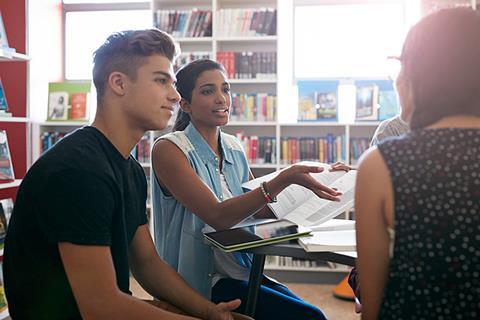In the first in this new series, Daniel Barber gives an introduction into Flipped Learning and the language classroom.

Flipped language learning
With the resources that many students now have available at home, educators are challenging the typical assumptions about which activities are best done in and outside class. Why spend time listening to basic explanations in class when you could listen to basic explanations online? Why practise pronunciation in class when audio playback and voice recording apps exist? Is home the best place for writing practice?
Think about it
Here are some activities in a lesson. Which ones are students more likely to do a) in class, b) at home or c) either in class or at home?
- students ask questions about some new language
- students do a group project
- students listen to an explanation about grammar
- students practise writing
- students record a conversation in groups
If we accept that class time is precious and should be spent on things that are best done in groups or need a teacher present, then you will probably agree that 1, 3, 4 and 6 need to be done in class, while students could do 2 and 5 either at home or in class. And if we can get students doing them at home, then we should, because this means more time to do other activities together. Traditional workbooks contain exercises consisting of controlled practice activities such as gap-fills, or solitary writing tasks, so they confirm this idea.
What is Flipped Learning?
Flipped Learning describes an increasingly common practice of doing more of what is traditionally done in class at home and more of what is done at home in class. The Flipped Learning Network defines it as an approach ’in which direct instruction moves from the group learning space to the individual learning space’;
‘the resulting group space is transformed into a dynamic, interactive learning environment where the educator guides students as they apply concepts and engage creatively in the subject matter.’
There are a number of potential advantages to organizing learning like this:
- If teachers spend less time talking, students have more opportunities to practise speaking and really use the language.
- If students are given the instructional content to study on their own, they can listen at their own pace and review parts they haven’t understood without disrupting others.
- Teachers have more time to focus on individuals in class.
- Teachers cover more of the syllabus in the little class time they have.
- Students have the tools to learn independently, to catch up on missed lessons and to revise and review at times which suit them.
Flipped language learning
You might be reading this and thinking: But my classes are already like this. After all, ELT often recognizes that lecture-style presentations aren’t very effective, and best practice language teaching minimizes teacher talk time and maximizes activation of language by students. As Laurie Harrison of ELT Jam points out, this ‘might not be particularly different from what many ELT teachers already do’.
In an interview with The TEFL Show, Russell Stannard, a specialist in technology for language learning suggested that by encouraging students to do more on their own, Flipped Learning is a suitable approach in today’s world:
‘The reality of the situation that we’re in now is that there’s so much learning content on the internet, there really is a need to empower students and to help them become more independent. The flipped classroom fits that scenario quite well. It puts a bit more onus on the students to work.’
Flipping shifts the focus of teaching from what happens in class to what happens away from class. In ‘From English Teacher to Learner Coach’, Duncan Foord and I emphasize the need for teachers to guide students in their everyday language lives, and flipping can help to achieve this:
‘The challenge for learners before the 1990s was access, access to spoken and written material in particular. The challenge now for learners is choice; how to manage and navigate the plethora of opportunities, in the face of a plethora of competing distractions.’
To think about – anticipating difficulties
Any approach has potential drawbacks. First, do all students have online access at home? Do they have time to study? Students with difficult home lives may struggle to study at home or lack the supportive family environment that it requires. Second, although we should welcome approaches that encourage autonomy, how do we prepare for students who don’t work at home? Without the teacher to answer specific questions and work through particular confusing points, how should students help themselves? Finally, communicative methodology takes an interactive and personalised approach to all aspects of learning, including language instruction. Grammar presentations or explanations of pronunciation and new vocabulary should not be one-way lectures but two-way dialogues, with the teacher constantly asking questions and fielding answers; it is a collaborative, group experience. How can video clips and slide shows compete with the rich learning moments possible in class?
Clearly, it’s crucial for teachers to anticipate these problems and find solutions. If students are expected to learn at home via videos and slide shows, there needs to be time planned in to the following lesson for the teacher to check understanding and clarify doubts. As with all anything new, it may be necessary to start small to give students time to get used to the approach, and for the teacher to iron out individual problems and find the right balance of flipped and standard lessons.
Conclusion
Flipped Learning may have one or two limitations in the language class because learning is less a question of memorising information and taking notes and more about the internalisation of words and rules through communication practice. Even so, there are areas of ELT where it could be effective, including:
- on blended learning courses, where much of the content is available in digital format.
- in exam preparation classes, where there isn’t time to cover all the material.
- in EAP classes and settings where instruction is complex.
- whenever students might benefit from greater variety in home study.
- in low-tech classrooms where students have better access to resources at home than at school.
- in mixed-ability classes, where flipping might allow for greater differentiation.
First steps into … Introduction

Daniel Barber gives an introduction to this new series about emerging pedagogies.
- 1
- 2
- 3
- 4
- 5
- 6
- 7
- 8
- 9
- 10
- 11
- 12
 Currently
reading
Currently
reading
First steps into … Flipped Learning









No comments yet